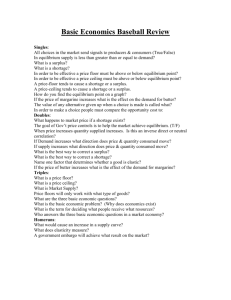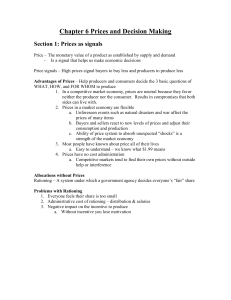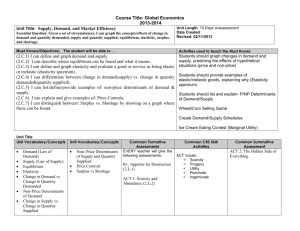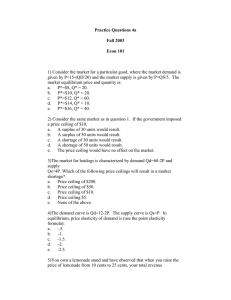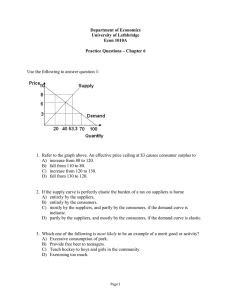Notes
advertisement
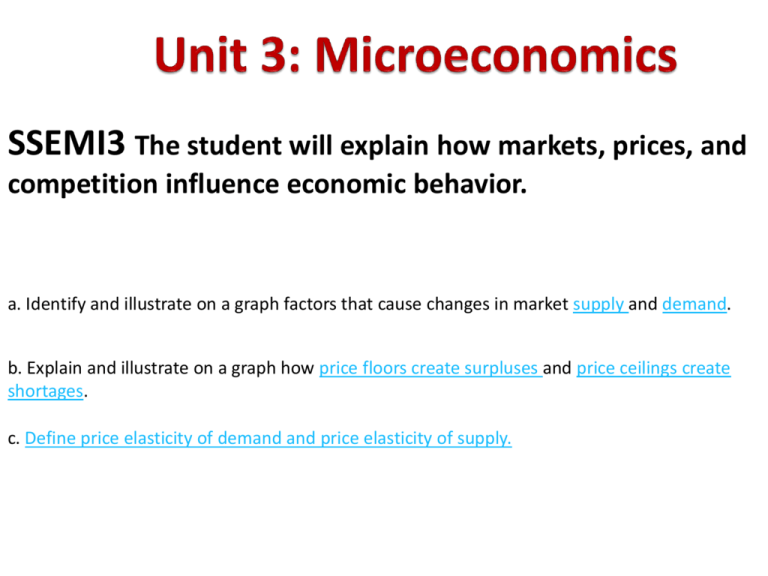
SSEMI3 The student will explain how markets, prices, and competition influence economic behavior. a. Identify and illustrate on a graph factors that cause changes in market supply and demand. b. Explain and illustrate on a graph how price floors create surpluses and price ceilings create shortages. c. Define price elasticity of demand and price elasticity of supply. Determinants of Demand Change in Consumer tastes/preferences Change in the number of buyers Change in consumer incomes Change in the prices of complementary and substitute goods Change in consumer expectations SSEMI3 The student will explain how markets, prices, and competition influence economic behavior. a. Identify and illustrate on a graph factors that cause changes in market supply and demand. Increase Demand Price Decrease Demand Demand Quantity Determinants of Supply •Change in Resource Prices (Input Prices) •Change in Technology •Change in Taxes or Subsidies •Change in producer expectations •Change in number of suppliers •Change in exogenous variables (bad weather,Terrorism, etc) •BOTTOMLINE ON SUPPLY CURVE SHIFTS –Anything that increases the cost of production decreases supply –Anything that decreases the cost of production increases supply SSEMI3 The student will explain how markets, prices, and competition influence economic behavior. a. Identify and illustrate on a graph factors that cause changes in market supply and demand. Supply Price Increase in Cost of production Decrease Supply Decrease in Cost of Production Increase Supply Quantity A Price Ceiling is a maximum legal price BELOW the equilibrium. • It provides perverse incentives, causing a shortage. • Helps the Consumer • Ceiling, below, shortage (CBS) A Price Floor is a minimum legal price ABOVE the equilibrium • It provides perverse incentives, causing a surplus. • Helps the Producer • Floor, above, surplus (FAS) Supply 5 4 Price Floor Price 3 Equilibrium 2 Price Ceiling 1 Demand 1 2 3 Quantity 4 5 Price controls (ceiling) • Assume that a market is in equilibrium and there is no change in supply or demand; relative scarcity has not changed. • A government sets a legal price below the equilibrium (price ceiling) • Buyers will want to buy (more or less). • Suppliers will want to supply (more or less). • There is a (surplus or shortage). • Rent controls, doctors, prescription drugs Price controls (floor) • Assume that a market is in equilibrium and there is no change in supply or demand; relative scarcity has not changed. • A government sets a legal price above the equilibrium (Price Floor) • Buyers will want to buy (more or less). • Suppliers will want to supply (more or less). • There is a (surplus or shortage). • Minimum wage, agricultural price supports SSEMI3 The student will explain how markets, prices, and competition influence economic behavior. c. Define price elasticity of demand and price elasticity of supply. Demand Inelasticity – demand that is not sensitive to price change Demand Elasticity – demand is sensitive to price change Supply Inelasticity – firms find it hard to change production in a given time period. Supply Elasticity – producers can increase output without a rise in cost or a time delay http://www.tutor2u.net/economics/revision-notes/as-markets-price-elasticity-of-supply.html




